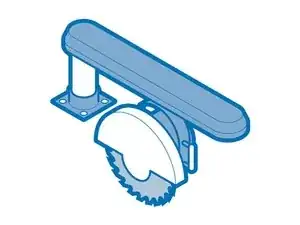Radial Arm Saws
A radial arm saw is a powerful stationary woodworking tool used to make accurate cuts in wood. It features a circular saw blade attached to a movable arm that can be adjusted to different angles. The arm slides along a horizontal beam, allowing the blade to be moved over the surface of the wood. Radial arm saws are capable of making cross cuts, miter cuts, bevel cuts, rip cuts, and dado cuts. They are a versatile tool used by both hobbyists and professionals.
Structure and Durability
Radial arm saws are built to last. They typically have a cast iron, cast aluminum, or steel frame that reduces vibration. The heavy-duty construction means radial arm saws can withstand intensive use over many years. Radial arm saws earn their reputation for reliability through their near indestructible design.
Features
- Circular saw blade (10 to 22 inches in diameter) attached to an arm that can slide horizontally and vertically
- Arm can pivot to different angles for miter and bevel cuts
- Capable of making cross cuts, miter cuts, bevel cuts, rip cuts, and dado cuts
- Powered by electricity, requires a power source and typically 220V. Note: Stationary tool, not meant to be portable
- Safety features like blade guards, splitters, and anti-kickback pawls
- Dust collection ports to connect to dust extraction
Comparison to Miter Saws
While radial arm saws and miter saws are both commonly used for woodworking, there are some key differences:
- Cutting depth: Radial arm saws typically have larger blade sizes, from 10 to 22 inches, allowing them to cut much thicker wood than the typical 8 to 12 inch miter saw blade.
- Versatility: Radial arm saws can make a wider variety of cuts, including crosscuts, miters, bevels, dados, and rips. Miter saws are more limited to crosscuts, miters, and bevels.
- Portability: Miter saws are designed to be portable, while radial arm saws are stationary tools that are difficult to move.
- Precision: Miter saws typically offer more precision, especially for beginners. Radial arm saws can achieve high precision but have a steeper learning curve.
- Safety: Miter saws have more safety features like blade guards and dust collection. Radial arm saws can be more dangerous if not used properly.
While miter saws and radial arm saws overlap in function, radial arm saws are better suited for a professional woodworking shop where their versatility, power, and wide cutting capacity are useful. For most DIYers and hobbyists, a miter saw may be a safer and more practical choice. But for those looking to do it all, the radial arm saw still proves its worth.
Advantages
- Powerful cuts: Radial arm saws can handle thick, hardwoods and cut deep
- Versatile: Capable of many types of cuts for various woodworking projects
- Large cutting capacity: Can cut very wide boards due to the sliding arm
Disadvantages
- Safety: The large, exposed blade and mobility of the arm pose risks of injury if not used properly
- Lacks precision: More difficult to make ultra-precise cuts compared to other tools like miter saws
- Requires space: Radial arm saws are large stationary tools and require ample work space
Types of Cuts
A radial arm saw can make the following types of cuts:
- Cross cuts: Cutting across the grain of the wood at a 90 degree angle. The wood is placed against the backstop or fence and pushed into the blade.
- Rip cuts: Cutting along the grain of the wood. The wood is placed on the table and slid into the blade while it's cutting. Can be dangerous if kickback occurs.
- Miter cuts: Angled cuts, often at 45 degrees. The arm of the saw is pivoted to the desired angle to make cuts at an angle other than 90 degrees.
- Bevel cuts: Angled cuts through the thickness of the wood. The arm pivots to angle the blade relative to the surface of the wood.
- Dado cuts: Grooves cut across the grain of the wood. A dado blade is installed on the radial arm saw to make these cuts.
- Compound cuts: A combination of a miter and bevel cut. The arm is pivoted in two directions to cut at a compound angle.

